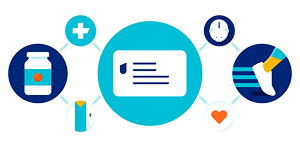When it comes to your health, you don’t want to cut corners. But seeing a doctor, getting tests or going to the emergency room can be expensive, even if you have health insurance coverage. For example, if you have a certain type of insurance that requires you to see an in-network provider, but you go out of network, that could cost you more.
The good news is that there are some steps you can take to help limit your out-of-pocket health costs. In other words, you can get the knowledge you need to save, even before you buy a certain type of insurance.
Here are 6 ways to find the best price on medical care, while still getting the care you need.
Got questions about what your plan covers at no additional cost to you? Get more details now, or call a licensed insurance agent at 1-844-211-7730.
1. Shop around for doctors and treatments
Just as you would do to find the best price on a car or a computer, there’s no reason not to do the same — compare costs — for your medical care.
In fact, most health insurance websites have a cost-estimator tool. You can use it to estimate the amount of money it may cost you for certain health care services. Those might include the average costs for in-network providers like:
- Doctors
- Hospitals
- Labs
- Mental health services
- Office visits
Jeffrey Gold, M.D., a primary care/family physician at Gold Direct Care in Salem, Massachusetts, also suggests that, whenever possible, you go to an outpatient facility for imaging tests, procedures and surgeries. He says that outpatient facilities can be cheaper than having the same procedure done at a hospital.
2. Check with your doctor about less expensive medications
Ask your doctor if you can switch one or all of your prescription drugs to the generic version. If there isn’t a generic version, ask if there’s a similar, less expensive medication.
You can also try to find a mail-order pharmacy for your long-term medicines, such as blood pressure drugs. But also check whether your health plan offers one. Often, you can order a 90-day supply of medication with a lower copayment amount. (That’s a fixed amount you pay for health services.)
3. Use your health accounts
If you have a health account, you may be able to use pretax dollars to save on health care costs. There are 2 types of health accounts:
- A Health Savings Account, or HSA, is a type of savings account you can put pretax dollars in. Those funds can then be spent on eligible health expenses. But you’ll need to have a high deductible health plan to have an HSA.
- A Flexible Spending Account, or FSA, is a type of health account that allows you to set aside pretax money for health care costs. You may be able to sign up for one through your employer.
If you sign up for either of these options, it’s a good idea to use them, advises Dr. Gold. HSAs are owned by you, earn interest and can be rolled over from year to year. “These are great savings tools to have in case something major happens,” he explains.
Unlike HSAs, FSAs don’t earn interest and generally must be used within the calendar year. But both types of health accounts can help you save hundreds of dollars each year.
4. Choose in-network health care providers
Even if your health insurance plan allows you to see out-of-network providers, you’ll usually pay less if you see someone in the network. If a provider is out of network, it means they aren’t in contract with your insurance company. When a provider is in network, it means that they have a contract with your health plan, so they charge lower rates.
Wondering which health plan is right for you? Get more details now, or call a licensed insurance agent at 1-844-211-7730.
5. Choose the right health plan
Think about your health needs. Do you have a chronic condition that requires frequent care, such as type 2 diabetes or heart disease? If so, you may be better off with a plan that has a higher premium (your monthly insurance bill) but covers more of your health costs.
If you are healthy and rarely need to see the doctor, you may want to opt for a plan with a lower premium. These plans usually have higher deductibles (what you have to pay before your insurance pays the rest), but it may be worth it if you only see your doctor for preventive care.
6. Don’t forget about urgent care
A trip to the ER can cost a lot more than a visit to an urgent care walk-in clinic or a virtual visit. If you need medical attention and your doctor’s office is closed, think about how quickly you need care.
If it is an emergency, life-threatening, or something that can potentially cause permanent harm (for example, chest pain, heavy bleeding or trouble breathing), don’t delay. Call 911 or head to the emergency room right away.
But if you are sure that you don’t need to be treated immediately, you can often be treated at an urgent care center. That might be for something such as:
- Minor burn
- Possible sprain
- Sore throat
For example, if you think you’ve broken a bone, you don’t have to wait to go to your doctor’s office to get an X-ray. You can usually get one at an urgent care. And urgent care centers can be in your network, which would mean your health care costs could be lower.
However, you don’t want to confuse an urgent care center with a freestanding emergency room, which you may also see referred to as an “urgency center.” While urgency centers are often open 24/7, they aren’t typically affiliated with a hospital.
Urgency centers may treat many of the same conditions as a traditional emergency room, but they may be out of your insurance network. For that reason, you could end up paying much higher costs if you go to one instead of an urgent care.
Got questions? Find information online, or call a licensed insurance agent at 1-844-211-7730 to discuss your options.
Sources:
- National Library of Medicine: MedlinePlus. “Eight ways to cut your health care costs.” August 11, 2022. Retrieved from https://medlineplus.gov/ency/patientinstructions/000870.htm
- National Library of Medicine: MedlinePlus. “How to save money on medicines.” August 11, 2022. Retrieved from https://medlineplus.gov/ency/patientinstructions/000863.htm
- National Library of Medicine: MedlinePlus. “When to use the emergency room — adult.” July 25, 2022. Retrieved from https://medlineplus.gov/ency/patientinstructions/000593.htm
Compliance code:
50528-X-1223










